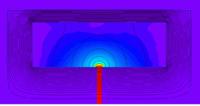T
treez
Guest

Hello
I have just calculated that a 1.25mm gap in the centre post (only) of the following core......PQ50/50-3C96
...will give an inductance of 341uH with 33 turns, and the saturation current will be 9A7.
(considering 0.3T = saturation)
However, i used the Effective core area (Ae) in the calculation and not the minimum core area (Amin).
...Is this correct, or do i need to use the area of just the centre post, where the gap will be?
PQ50/50-3C96 datasheet:
https://www.ferroxcube.com/prod/assets/pq5050.pdf
I do this by calculating reluctance via Rel = length/(u0.ur.A), then L = N^2/Reluctance
...i calculate reluctance of ferrite and gap then add them ....but which Area value gets used for core and air gap?
I have just calculated that a 1.25mm gap in the centre post (only) of the following core......PQ50/50-3C96
...will give an inductance of 341uH with 33 turns, and the saturation current will be 9A7.
(considering 0.3T = saturation)
However, i used the Effective core area (Ae) in the calculation and not the minimum core area (Amin).
...Is this correct, or do i need to use the area of just the centre post, where the gap will be?
PQ50/50-3C96 datasheet:
https://www.ferroxcube.com/prod/assets/pq5050.pdf
I do this by calculating reluctance via Rel = length/(u0.ur.A), then L = N^2/Reluctance
...i calculate reluctance of ferrite and gap then add them ....but which Area value gets used for core and air gap?
Last edited by a moderator:



